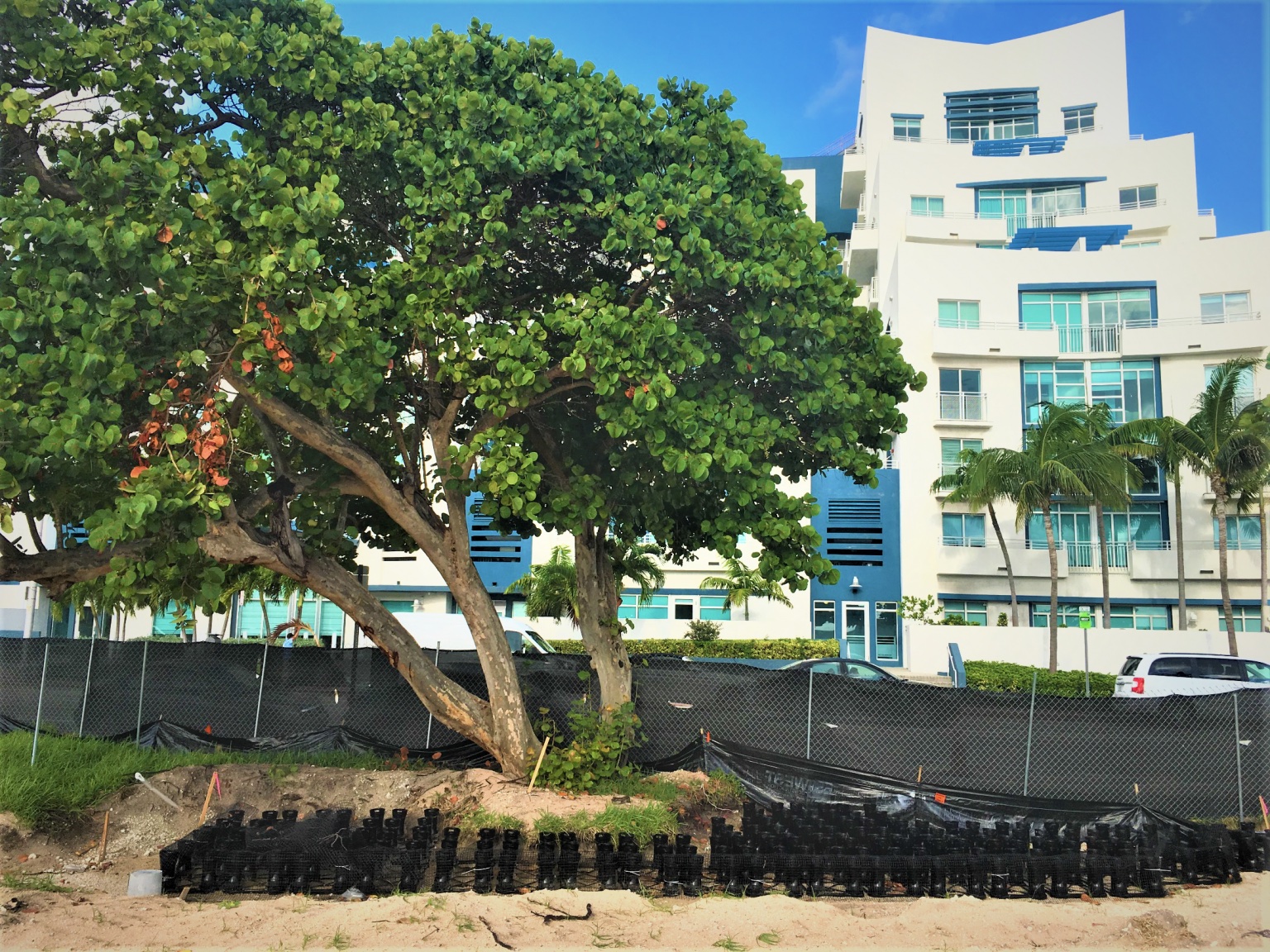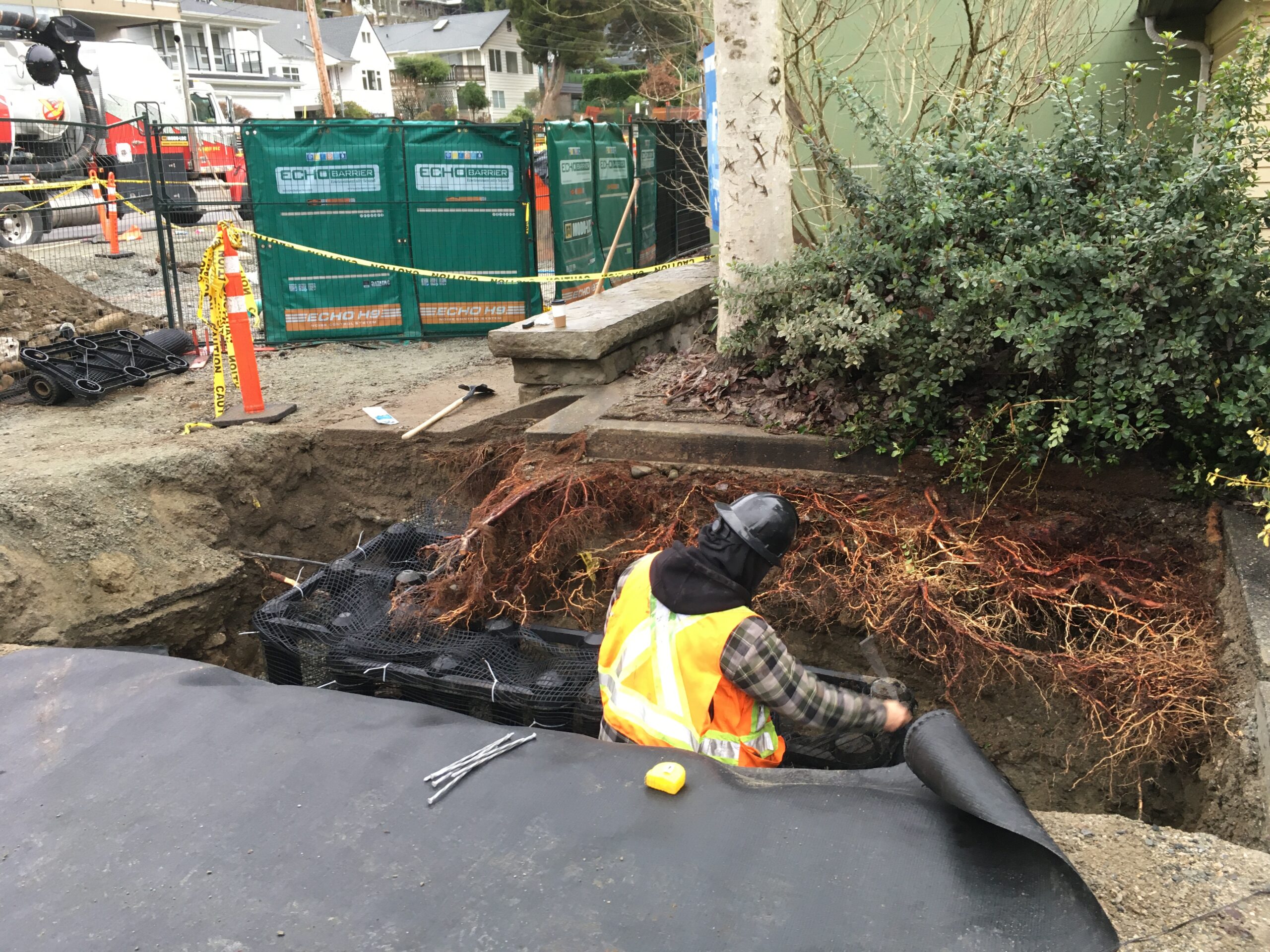While the Silva Cell system is typically utilized to provide soil volume and stormwater management to new tree plantings, there are many circumstances where saving an existing tree is the goal. With care and consideration, Silva Cells can be installed to provide the soil volume needed to support an existing tree — but there are a number of factors to examine.
Here are some things to consider when determining if Silva Cells should be used around an existing tree in your project.
It’s helpful to begin by understanding the basics of preserving trees during land development. A good resource is a book by Jim Clark and Nelda Matheny titled Trees and Development.
You should also consult a local arborist to assist in an assessment of the existing tree and its surrounding conditions. An ASCA arborist will help you better understand the project’s most pressing questions, including:
It’s important to partner with your arborist throughout the project, as they will be able to both provide initial insight on what’s to come and help direct action during the excavation and root-cutting process.
There are three primary reasons to utilize the DeepRoot Silva Cell system with an existing tree:
The most common of these reasons is an impending construction project. Oftentimes an improvement initiative along a roadway or sidewalk will interfere with the tree itself or its root area — but you may want to keep the tree intact, despite the new area conditions. This is a perfect scenario in which to incorporate Silva Cells.
The Silva Cell system, properly installed around an existing tree, will provide that tree with a soil bank to expand its root zone. The uncompacted soil incorporated into the Silva Cells’ void space helps compensate for the damage to roots or the loss of adequate soil volume caused by disruptive construction work.
For instance, a grassy area could be getting replaced with a sidewalk — in which case, the tree’s root space becomes limited in growth. This obstacle is mitigated with the Silva Cell system, which supports the weight of the pavement above while creating a loamy soil environment for the roots. Silva Cells can also act as an underground bridge, connecting the tree to nearby uncompacted soil conditions — say, beneath the grass at an adjacent park — by giving the roots a connective pathway.
Existing tree roots can also be prevented from damaging infrastructure by adding Silva Cells in a preferred direction for the roots to grow, thereby helping them establish a path away from the potential damage area. Depending on the situation, it may be advisable to do so in conjunction with root pruning and the installation of DeepRoot root barriers.
When deciding if Silva Cells are a good choice for your existing tree, there are a number of things to consider. Firstly, you should perform an honest assessment of the tree’s current condition and health. An unhealthy tree may not be worth the time and expense of a rescue project — again, an arborist should help with this process.
The cost of the project — and the difficulty in providing an accurate estimate — should also be acknowledged. Given the site-specific conditions for each project, it’s challenging to know exactly what the price tag will be. This is especially true with excavation costs, which vary based on the tree’s individual needs.
Finally, it’s important to note that, if you do decide to use Silva Cells with an existing tree, the tree opening will almost certainly be disturbed. The excavation and root-maintenance process changes the landscape, and the tree opening is typically larger at the completion of the project than when it began.

The following are some examples of DeepRoot success working with existing trees on projects in the United States and Canada.
This 20-year-old Bowhall Maple Tree was originally slated to be removed as part of the Gallant Avenue reconstruction. The tree had become root bound in its original planter and was pulling up the adjacent pavers; however, the merchants and the district arborist wanted to try to save the tree due to its size and location next to the new pedestrian walkway.
In conjunction with the city arborist, DeepRoot proposed that the contractor Hydro-Vac around the perimeter of the planter to expose the tree roots. During this process, the arborist identified root structures that could be pruned and support roots that should be retained. The Silva Cells were the solution to retain root structure without damaging them. They were installed at the perimeter of what would be the new expanded planter wall.
The modular/open structure of the Silva Cells allowed us to build the Silva Cells around the retained root structures without damaging them. This process provided the tree with a new lease on life with an expanded planter and soil volume. The Silva Cells around the perimeter of the planter provided support for the new planter wall while maximizing the soil volume available to the tree.
Read more about this ongoing project by reading our case study.
At the corner of East Wheelock and South Main Street in Hanover, New Hampshire, the Hanover Inn overlooks the scenic Dartmouth College Green. As part of a significant redevelopment of the historic property, project engineers Greenman-Pederson (GPI) chose to preserve two 20-year-old, 12” DBH American Elms (Ulmus Americana). In keeping with the historic inn and leafy Ivy League College setting, it was critical to maintain the Elm trees to provide a sense of legacy to the site.
A two-acre grassy oceanfront with a few trees in Miami Beach was transformed into an urban park in 2019. Sandwiched between apartments and a public beach, more urban trees and green space were added alongside a number of existing trees, which are now receiving rejuvenated life thanks to the Silva Cells installed under the newly constructed adjacent pathways.
Read more about this project by reading our case study.
The city of Niagara Falls updated Queen Street in 2011 with new trees that included Silva Cells to provide adequate soil volume. Several years earlier, the city had planted trees on Queen Street in standard 3’x 3’ tree pits dug into the highly compacted (95 Proctor) soils under the sidewalk. Many of these trees had failed due to lack of proper soil volume. Eleven of the existing trees were deemed healthy enough to try to save — this was achieved by excavating to the drip line on both sides of the existing trees, selective root pruning, and by installing a soil bank of Silva Cells.
The trees were given a second chance by providing a new source of uncompacted soil and nutrients in the adjacent Silva Cells. Their growth in the last decade has been impressive.
The USTA Billie Jean King National Tennis Center at Flushing Meadows in Queens, New York, is the world’s largest public tennis facility and the host of the U.S. Open. The landscape reconstruction work for the major plaza between the stadium included a central alley of 10 existing Honey Locust trees, which were performing poorly due to the compacted nature of the site soil. Thousands of visitors each day during tournaments now enjoy the dappled shade of the healthy trees.
